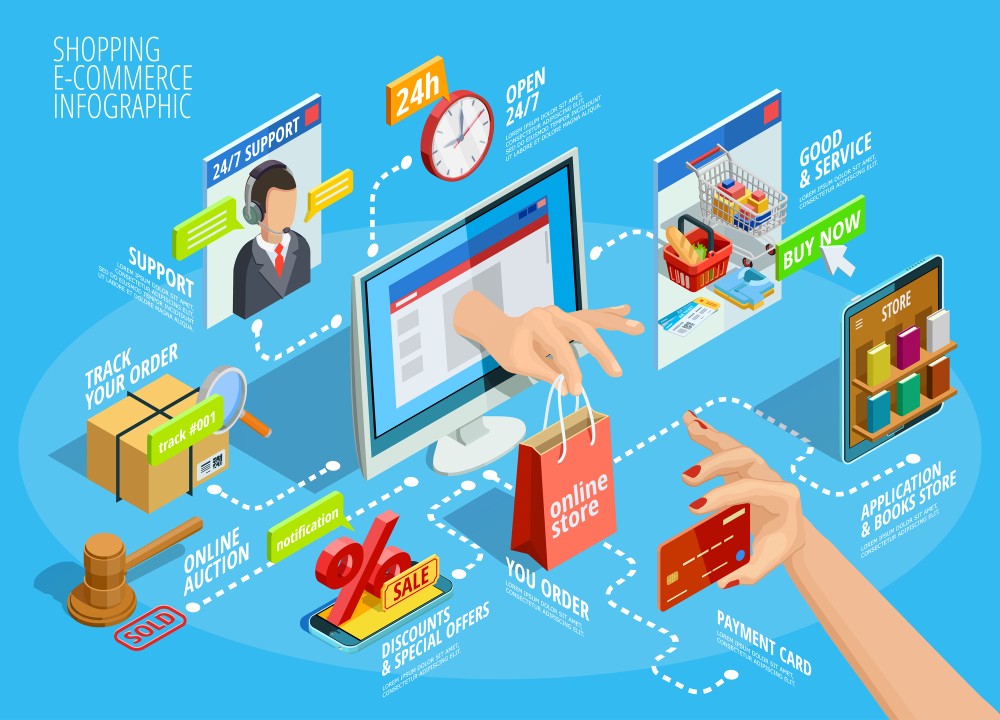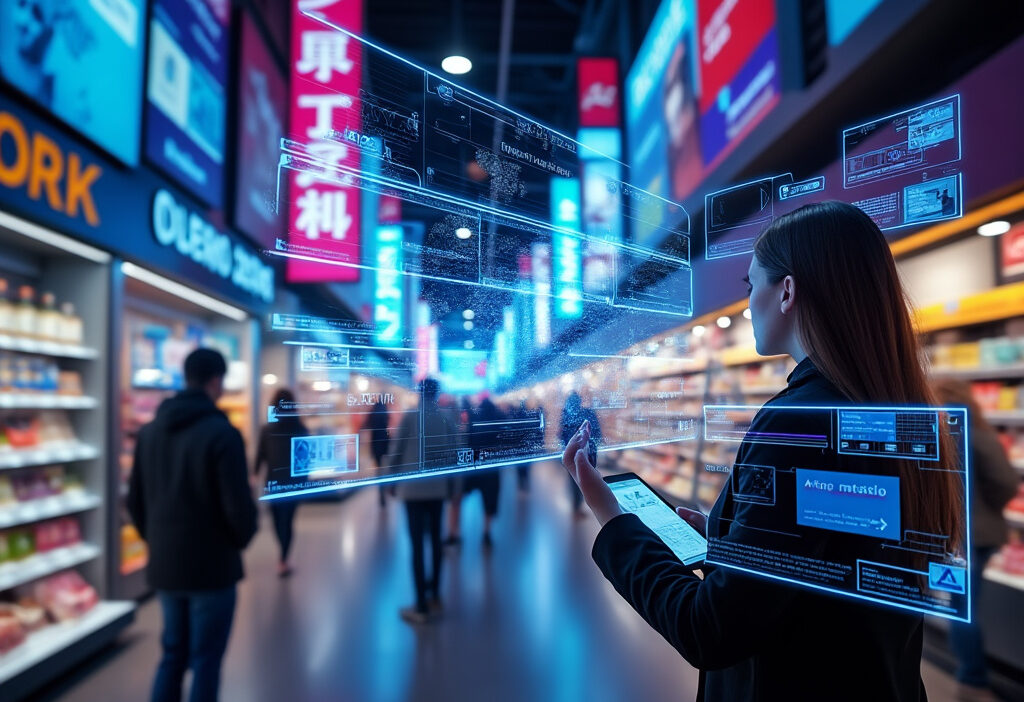Navigating the Future of Shopping with Personalized E-Commerce in 2025
As we step into 2025, personalized e-commerce is revolutionizing the way we shop online. Through the power of artificial intelligence, data analytics, and evolving consumer expectations, digital retailers are now offering tailor-made shopping experiences. This article delves deeper into how these technologies are transforming online shopping, making every customer interaction uniquely personal.
The Evolution of E-Commerce to Personalization
The shift from traditional e-commerce to personalized digital shopping experiences marks a pivotal evolution in retail. In 2025, the one-size-fits-all approach is obsolete, replaced by hyper-personalized interactions driven by AI and big data. Retailers no longer just sell products—they curate experiences tailored to individual preferences, behaviors, and even emotions.
At the core of this transformation is the ability to decode consumer intent. Advanced machine learning algorithms analyze vast datasets—purchase history, browsing patterns, social media activity, and even real-time interactions—to predict what shoppers want before they articulate it. For example, a customer browsing winter coats might receive recommendations not just based on past purchases but also on local weather forecasts and trending styles in their social circles.
Predictive analytics further refine these insights, enabling retailers to anticipate needs dynamically. If a user frequently buys organic skincare, an AI-powered platform might suggest a new eco-friendly brand right as they run low on their current product. This level of personalization extends beyond product suggestions to pricing, promotions, and even delivery options, all optimized for individual convenience.
The role of big data is equally critical. By aggregating and anonymizing data from millions of transactions, retailers identify macro-trends while preserving privacy. Techniques like federated learning allow AI models to improve without exposing sensitive user information, balancing personalization with security.
As e-commerce becomes increasingly individualized, the line between digital and physical retail blurs. Virtual try-ons, AI stylists, and contextual recommendations create seamless, intuitive journeys. This sets the stage for the next frontier: generative AI, which will take personalization from reactive to creative, crafting unique content and interactions in real time.
Generative AI Transforming Shopping Experiences
Generative AI is revolutionizing e-commerce by enabling unprecedented levels of personalization, transforming how shoppers interact with digital storefronts in 2025. Unlike traditional recommendation engines that rely on static algorithms, generative AI dynamically crafts content, product suggestions, and even customer service interactions in real time, adapting to each user’s unique preferences and behaviors.
One of the most impactful applications is in dynamic content generation. AI-powered tools now analyze browsing history, past purchases, and even contextual cues like time of day or device type to generate personalized product descriptions, tailored promotions, and even custom landing pages. For example, a fashion retailer might display different homepage banners for a returning customer based on their style preferences, while a first-time visitor sees trending items aligned with their demographic profile.
Product recommendations have also evolved beyond simple “customers who bought this also bought” suggestions. Generative AI synthesizes vast datasets—including social media activity, wish lists, and abandoned carts—to predict what a shopper might want next, often before they realize it themselves. Advanced models can even simulate hypothetical shopping scenarios, adjusting recommendations based on real-time interactions, such as hovering over a product or lingering on a specific category.
Customer service has been similarly transformed. AI chatbots, powered by generative models, now engage in natural, context-aware conversations, resolving queries with personalized responses. These bots can suggest troubleshooting steps for a recently purchased gadget or recommend complementary products based on a customer’s purchase history—all without human intervention.
As generative AI continues to refine its understanding of individual shoppers, the line between digital and in-store experiences blurs further, setting the stage for the next frontier: hyper-personalization.
The Power of Hyper-Personalization
In 2025, hyper-personalization is no longer a luxury—it’s the backbone of competitive e-commerce. Unlike traditional personalization, which segments customers into broad categories, hyper-personalization leverages AI-driven insights to deliver individualized experiences at scale. By analyzing vast datasets—from past purchases and browsing behavior to real-time interactions—AI predicts customer desires with startling accuracy, creating a shopping journey that feels uniquely tailored to each user.
The key lies in the fusion of historical data and real-time analytics. Machine learning models process years of transactional data to identify long-term preferences, while live behavioral tracking adjusts recommendations on the fly. For instance, if a customer hesitates on a product page, AI can instantly refine suggestions based on their dwell time, mouse movements, or even sentiment analysis from chat interactions. This dynamic approach doesn’t just boost engagement—it drives revenue by reducing decision fatigue and shortening the path to purchase.
Retailers are also harnessing predictive analytics to anticipate needs before customers articulate them. Imagine a fitness enthusiast receiving a pre-emptive notification about restocking their favorite protein powder just as their supply runs low. Or a parent being shown back-to-school deals the moment their child’s school emails a supply list. These micro-moments of relevance foster deeper emotional connections, priming the groundwork for the loyalty and conversion strategies explored in the next chapter.
The result? A shopping experience so intuitive it feels like the digital equivalent of a trusted personal shopper—one that remembers every preference, adapts to shifting tastes, and surprises customers with uncanny precision. In 2025, hyper-personalization isn’t just a strategy—it’s the new standard for digital retail.
Boosting Loyalty and Conversion through Personalized Experiences
In 2025, personalized e-commerce isn’t just a trend—it’s a necessity for fostering customer loyalty and driving conversions. As AI and data analytics refine their ability to tailor shopping experiences, brands are witnessing a direct correlation between personalization and repeat purchases. When shoppers feel recognized and understood, they’re far more likely to return, transforming one-time buyers into lifelong advocates.
Why does personalization boost loyalty? It’s simple: relevance. AI-powered recommendations, dynamic pricing, and curated product selections make customers feel like the shopping journey was designed just for them. Research shows that 78% of consumers are more likely to repurchase from brands that personalize interactions, while 64% are willing to pay a premium for such experiences. This emotional connection fosters trust, a critical factor in long-term retention.
The impact on conversions is equally profound. Personalized product suggestions, based on browsing history and purchase patterns, can increase conversion rates by up to 30%. For example, a shopper who abandoned a cart might receive a tailored email with complementary items or a limited-time discount, nudging them toward completion. AI-driven chatbots further enhance this by providing real-time assistance, mimicking the in-store experience.
However, the key lies in authenticity. Over-personalization can feel invasive, so brands must strike a balance. Leveraging zero- and first-party data—as explored in the next chapter—ensures transparency while maintaining relevance. By 2025, the most successful e-commerce players will be those that don’t just sell products but craft individualized narratives, turning every interaction into an opportunity to deepen loyalty and maximize sales.
Navigating a Cookieless Future
As e-commerce evolves in 2025, the decline of third-party cookies is reshaping how brands deliver personalized shopping experiences. Without relying on invasive tracking, retailers are turning to first-party data—information willingly shared by customers—to craft tailored interactions. This shift isn’t just about compliance; it’s an opportunity to build deeper trust through transparency and value-driven exchanges.
The key lies in fostering direct relationships with consumers. Brands are incentivizing shoppers to share preferences, purchase history, and behavioral data by offering exclusive discounts, early access to products, or personalized recommendations. For example, a fashion retailer might ask customers to complete a style quiz in exchange for a curated seasonal lookbook. This value exchange ensures data collection feels mutually beneficial rather than exploitative.
Advanced AI-driven analytics now process first-party data to predict needs before customers articulate them. Machine learning models analyze browsing patterns, past purchases, and even customer service interactions to refine product suggestions. Unlike third-party cookies, which often deliver irrelevant ads, first-party insights enable hyper-relevant experiences—like suggesting a running shoe restock just as a customer’s current pair wears out.
Privacy remains paramount. Brands adopting zero-party data strategies—where users explicitly share preferences—are gaining an edge. Transparent data policies and granular consent options reassure shoppers, reinforcing loyalty. As mobile and AR technologies advance (as explored in the next chapter), these ethical personalization tactics will seamlessly integrate into immersive, on-the-go shopping experiences.
The cookieless future isn’t a limitation—it’s a catalyst for innovation, pushing e-commerce toward smarter, more respectful customer engagement.
Enhancing E-Commerce with Mobile and AR Technologies
In 2025, mobile personalization and augmented reality (AR) are no longer optional for e-commerce—they are the backbone of immersive, tailored shopping experiences. As brands navigate a cookieless landscape, mobile devices and AR fill the gap by offering hyper-personalized interactions rooted in first-party data. Mobile apps now leverage real-time behavioral analytics to adjust layouts, product displays, and promotions dynamically, ensuring every user sees content curated to their preferences. For instance, a shopper browsing sneakers might receive instant recommendations based on past purchases, location-based inventory, or even weather conditions—all optimized for their device.
AR takes personalization further by bridging the digital-physical divide. Virtual try-ons, 3D product previews, and interactive overlays empower customers to experience products before buying. Beauty brands, for example, use AR to simulate makeup shades on a user’s skin tone, while furniture retailers enable shoppers to visualize couches in their living rooms. These features reduce returns and build confidence, as decisions are informed by contextual realism.
Behind the scenes, AI stitches together mobile and AR data—like touch interactions, dwell time, and AR engagement—to refine recommendations. Unlike static desktop browsing, mobile and AR generate richer intent signals, allowing brands to predict needs before a customer even searches. This seamless integration sets the stage for the next frontier: voice search and smart assistants, which will further blur the lines between discovery and purchase. By 2025, the combination of mobile personalization and AR isn’t just enhancing e-commerce—it’s redefining how consumers connect with products in a digital-first world.
The Rise of Voice Search and Smart Recommendations
The rise of voice search and smart recommendations is reshaping personalized e-commerce in 2025, as consumers increasingly rely on conversational AI to streamline their shopping journeys. With over 60% of online searches now conducted via voice, retailers are leveraging this shift to deliver hyper-personalized product suggestions. Smart assistants like Alexa, Google Assistant, and bespoke retail AI tools analyze voice queries, past purchases, and behavioral data to curate tailored recommendations in real time.
Unlike traditional text-based searches, voice interactions provide richer context—tone, phrasing, and even hesitation patterns—enabling AI to infer intent more accurately. For example, a customer asking, “What’s a good skincare routine for dry winter skin?” triggers a multi-layered response: the AI cross-references local weather data, the user’s purchase history, and trending product reviews to suggest a bundled regimen. This level of personalization extends beyond simple keyword matching, creating a conversational commerce experience that feels intuitive and human-like.
Retailers are also integrating voice search with visual and AR capabilities, allowing users to verbally request “Show me how this sofa looks in my living room” and instantly see an overlay via smart glasses or mobile AR. Behind the scenes, reinforcement learning algorithms refine suggestions based on engagement metrics, ensuring each interaction becomes more precise.
The next frontier lies in predictive voice commerce, where AI anticipates needs before they’re voiced—like suggesting a replenishment order for a frequently bought item when a user asks, “What’s on my shopping list?” As brands invest in Centers of Excellence for Personalization, voice data will become a cornerstone for crafting seamless, anticipatory customer journeys.
Building Centers of Excellence for Personalization
As voice search and smart recommendations reshape how consumers interact with e-commerce, leading brands are doubling down on personalization by establishing Centers of Excellence (CoEs) dedicated to crafting hyper-relevant shopping experiences. These specialized teams combine data science, AI, and creative strategy to refine every touchpoint in the customer journey, ensuring that personalization isn’t just an add-on but a core business function.
By 2025, CoEs are no longer experimental—they’re mission-critical. These hubs integrate real-time behavioral data from voice interactions, browsing patterns, and purchase histories to build dynamic customer profiles. Advanced AI models then process this data to predict preferences, automate tailored product suggestions, and even adjust pricing or promotions in real time. For example, a fashion retailer’s CoE might use computer vision to analyze past purchases and social media trends, then generate personalized lookbooks for individual shoppers.
The most successful CoEs operate with a cross-functional approach, uniting marketers, engineers, and UX designers under a shared goal: seamless personalization at scale. Key strategies include:
- Modular AI architectures that allow rapid testing of new algorithms without disrupting existing systems.
- Predictive analytics to anticipate demand shifts and adjust inventory or recommendations proactively.
- Creative automation tools that generate custom ad copy, emails, or product descriptions tailored to individual users.
However, the rise of CoEs also demands robust governance. As the next chapter explores, balancing innovation with ethical data use is paramount. Leading brands are already embedding privacy-by-design principles into their CoEs, ensuring transparency while delivering unmatched relevance—a delicate equilibrium that will define e-commerce success in 2025 and beyond.
Ensuring Privacy and Transparency in Personalized Shopping
As brands establish Centers of Excellence to refine personalization strategies, the ethical handling of customer data becomes paramount. In 2025, personalized e-commerce thrives on trust, with transparency and privacy at its core. Retailers must balance hyper-personalization with respect for user consent, ensuring that data-driven experiences do not come at the cost of consumer confidence.
Leading retailers now employ zero-party data strategies, where customers willingly share preferences in exchange for tailored recommendations. Unlike passive tracking, this approach fosters mutual trust. Companies like Amazon and Nike use preference centers, allowing shoppers to control what data is collected and how it’s used. This shift from covert data mining to explicit consent marks a critical evolution in digital retail ethics.
Advanced AI-driven anonymization techniques further protect privacy. By processing behavioral patterns without storing personally identifiable information (PII), retailers deliver personalization while minimizing risk. Blockchain is also emerging as a tool for transparency, enabling customers to audit how their data is utilized in real time.
Regulatory compliance, such as GDPR and CCPA, remains foundational, but forward-thinking brands go beyond legal requirements. They embed privacy into their personalization engines, ensuring algorithms prioritize ethical data use. For instance, Sephora’s Beauty Insider program now includes clear opt-in explanations, reinforcing trust through openness.
The future of personalized shopping hinges on this equilibrium—where cutting-edge AI meets unwavering transparency. As we look ahead to innovations in digital retail, maintaining this trust will be as critical as the technology itself.
Looking Ahead The Future of Personalized E-Commerce
As we look toward 2025, personalized e-commerce is poised to transcend the boundaries of today’s digital retail landscape. The convergence of AI, machine learning, and advanced data analytics will enable retailers to craft hyper-individualized shopping experiences that feel intuitive, seamless, and almost anticipatory. Unlike the static personalization of the past—limited to basic recommendations—future systems will leverage real-time behavioral insights, contextual awareness, and predictive modeling to dynamically adjust content, pricing, and even product availability for each shopper.
One of the most transformative shifts will be the integration of generative AI into the shopping journey. Imagine virtual assistants that don’t just suggest products but co-create them—generating custom designs, bundling unique offers, or even simulating how a piece of furniture would look in a user’s home before purchase. Retailers will also harness augmented reality (AR) and virtual try-ons to bridge the gap between online and offline experiences, reducing returns and increasing satisfaction.
Data will remain the backbone of personalization, but its application will evolve. Instead of relying solely on past behavior, systems will incorporate emotional AI—analyzing voice tone, facial expressions, and even biometric signals to gauge intent and mood. This will enable brands to adjust interactions in real time, offering support when frustration is detected or upselling when excitement peaks.
However, the future of personalized e-commerce isn’t just about technology—it’s about strategic agility. Retailers must balance innovation with ethical considerations, ensuring personalization enhances rather than intrudes. The winners in 2025 will be those who master the art of contextual relevance, delivering value without overwhelming the customer. The race is on to create experiences so intuitive that shopping feels less like a transaction and more like a conversation.

Conclusions
As we explore the advancements in personalized e-commerce in 2025, it’s clear that artificial intelligence, data analytics, and a commitment to customer-centricity are redefining the digital shopping experience. Retailers who embrace these technologies are not only setting new standards for personalization but also fostering loyalty and driving growth. The future of e-commerce is indeed personalized, promising a shopping experience where every interaction feels uniquely tailored to each customer.



